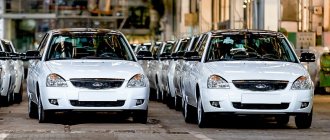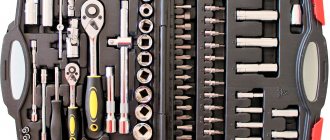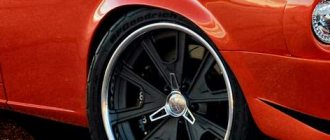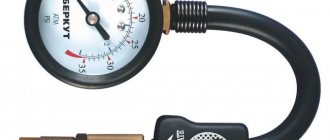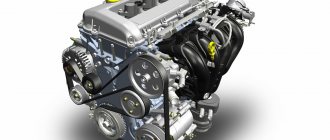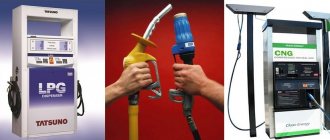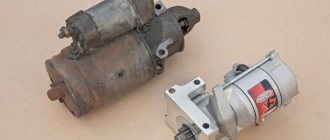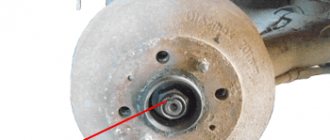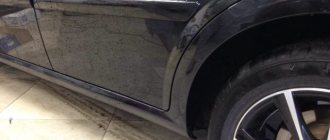Using the example of a front-wheel drive VAZ car, study the design of drives (CV joints) and master the technique of removing and installing wheel drives.
Explanation of work:
Torque from the gearbox is transmitted directly to the drive wheels, and is transformed through a mechanism called a drive differential.
The differential is designed to distribute torque between the driving wheels of the car and gives them the ability to rotate at different angular speeds.
Distributing torque equally between the drive wheels is advisable in cases where the car is moving on a road with a high coefficient of tire adhesion. This reduces the load on the wheel drive, slows down tire wear and reduces fuel consumption.
However, the drive wheels cannot always rotate at different angular speeds. When driving on curved streets and roads, when turning, the inner wheels roll along an arc of a smaller radius and travel a shorter distance than wheels rolling along an arc of a larger radius, i.e. along the outer track. Therefore, the outer wheels must rotate faster than the inner ones. The rotation speed of the wheels will also be different when the car drives over uneven roads and with different tire diameters. The drive wheels may have unequal diameters due to abnormal tire pressure, differential tire wear, or uneven load distribution in the vehicle body.
In order for the driving wheels of a car to rotate at different frequencies and travel different paths, it is necessary to install them not on a common axle, but on separate drive shafts and connect these shafts with a special mechanism capable of ensuring the rotation of the wheels at different frequencies.
Such a mechanism is
a differential.
It transmits torque from the driven gear of the main gear to the drive shafts of the wheels; in rear-wheel drive cars these are the axle shafts. For front-wheel drive cars, these are drives (CV joints).
The peculiarity of a front-wheel drive car lies primarily in the fact that the front steered wheels are simultaneously driving. To rotate the drive wheels, the drive shafts (half shafts) have ball joints, which must allow the wheels to rotate without changing the speed of their rotation. This condition is satisfied by constant velocity universal joints (synchronous ball joints). A conventional cardan joint quickly fails under these conditions, since the deviation of its driving and driven links creates an uneven angular velocity transmission of rotation to the driven link. This causes overload of the drive shafts and rapid wear of the universal joint.
In modern front-wheel drive cars, to drive the front wheels, axle shafts with two synchronous ball joints are used: for the drive wheel of a rigid type (with an angular degree of freedom), for a power unit of a universal type (with an angular and axial degree of freedom).
The front wheel drive used on the VAZ car is compact and reliable. The durability of the drive with proper operation of the vehicle is ensured by the perfection of the design of the hinges, the selection of improved materials, the precision of manufacturing of parts, good sealing of the hinges and the use of special lubricants.
The drive of each wheel consists of two joints of equal angular velocities and a shaft 10, which is solid for the left wheel drive (small), and tubular for the right wheel drive (large).
The outer hinge consists of a body 1, a separator 6, an inner race 3, and six balls. The hinge body and cage have grooves for placing balls. The grooves in the longitudinal plane are made along a radius, which ensures a rotation angle of the outer hinge of up to 40⁰. The splined tip of the hinge body is installed in the wheel hub and secured to it with a nut. Clip 3 is installed on the splines of shaft 10 between thrust ring 7 and retaining ring 2.
The internal hinge differs from the external one in that the tracks of the body and the cage are made straight, not radius, which allows the hinge parts to move in the longitudinal direction. This is necessary to compensate for movements caused by vibrations of the front suspension and power unit.
On a VAZ demonstration car with front-wheel drive, remove the drive and sketch the drive assembly.
The order of practical work:
We place the car on a lift or inspection ditch and perform the following operations on both sides of the car.
1. Loosen the front wheel mounting bolts, remove the cap, hubs and unscrew the wheel hub mounting nut on the outer joint housing;
2. Raise the front of the car and remove the front wheel;
3. Disconnect the ball joint of the suspension arm from the steering knuckle by unscrewing the bolts securing it;
Rear-wheel drive and its features
Rear-wheel drive is considered classic, since cars were originally produced with it. The peculiarity of a car with such contraction is that the functions of the wheels of both axles are separate. The front axle in such cars is only steerable, while the rear axle drives the car.
To ensure the transmission of torque to the wheels, rear-wheel drive cars use a rather complex transmission design, which includes a gearbox, a shaft with cardan joints, and the main gear is included in the rear drive axle. This design is typical for cars with a front-engine layout (it is the most common).
But at one time, cars with a rear-engine layout were produced. Their transmission design was simpler, since the distance from the gearbox to the wheels of the drive axle was minimal. Nowadays such an arrangement is extremely rare.
Advantages
The positive qualities of rear-wheel drive cars include:
- More varied load distribution between axles. The front-mounted engine places significant load on the front axle, while the rear axle is only affected by the weight of the body. But when the movement begins, the weight shifts back, due to which the load is distributed - the front axle is unloaded, and the rear axle is loaded. This ensures better traction of the wheels of the rear axle, which ensures good acceleration dynamics;
- Reduced steering vibration. Since the front axle is intended only for steering the car, the steering mechanism is affected exclusively by vibrations received by the wheels from the road surface;
- Large wheel turning angle. The design of the front axle also plays a role here. The absence of additional elements in the design allows the wheels to be turned to a larger angle, which provides better maneuverability in confined spaces (it’s easier to park);
- Reduced vibration transmission to the body. In rear-wheel drive cars, the power plant is located longitudinally, so the weight distribution to the front is more optimal. Additionally, the use of elastic vibration-damping motor mounts ensures minimal transmission of vibrations from the motor to the body;
- Predictability of skidding and ease of recovery. It is worth noting that this is a somewhat controversial merit. The fact is that a rear-wheel drive car is more susceptible to skidding, and if it were also difficult to get out of it, the popularity of this type of drive would be much lower.
Types of car drive systems - Advantages and disadvantages
Any citizen even far from cars knows that there are three main types of drive in cars, that is:
- rear-wheel drive, in which power and torque are taken off respectively to the rear axle;
- front-wheel drive, which operates on a diametrically opposite principle and has a diametrically opposite layout;
-all-wheel drive, which combines all the pros and cons of the two above drives.
But one way or another, for some reason, many motorist citizens still have many questions, namely, for what purposes, why and why various types of drives and layouts are used on certain vehicles. And also, why, for example, some small cars are equipped with front-wheel drive and not rear-wheel drive, and is the All Wheel Drive (AWD) system really not the same as, say, 4WD (4x4) technology?
Which drive is better
Because of such a misunderstanding, we decided to write an article in which we covered the topic: - a brief description of existing car transmissions, their advantages and disadvantages, along with the general principles of their operation.
For those citizens who are familiar with the structure of cars, this article will not be very interesting, since it was written specifically for novice drivers who have recently received their driver’s licenses (driving licenses) and do not have the slightest idea about the auto world in which they are entering. she is entering today.
As a small digression before starting our story, I would like to note that not all of the following statements must necessarily be true. Modern technologies and hybrid powertrains, as well as advanced materials, can significantly affect their use today, comparing or, on the contrary, distinguishing their advantages and disadvantages in various systems and types of vehicle drives.
Front-wheel drive
Front-wheel drive passenger cars began to be widely used in the 70s of the last century, although the first models with it appeared much earlier. The peculiarity of this type of drive is that rotation is transmitted to the front axle, that is, it is simultaneously controlled and driven. There are both positive and negative sides to this.
Positive traits
The advantages of front-wheel drive cars include:
- High rates of exchange rate stability. The front wheels “pull” the entire “cart” behind them;
- It is more difficult to skid a car with such a drive. Good directional stability is reflected here;
- Less metal consumption of the structure. The main gear is included in the gearbox device. In this case, the rotation is transmitted along a short path and for this purpose two small shafts with joints of equal angular velocities are used. All this significantly reduces the cost of production;
- Comparative simplicity of design;
- Increased usable interior space. Due to the absence of a cardan transmission, there is no need to create a volumetric tunnel (although it is still present);
- The best cross-country ability. It all depends on some factors. So, on long off-road conditions, due to the load on the front end, it is easier for the drive wheels to find a support point. In short sections, the dirt is often overcome due to the inertia of the car (thanks to it, the front simply “skips” the dirt and the wheels already “cling” to the hard surface);
- Smaller engine compartment dimensions. In front-wheel drive cars, the engine and gearbox are placed transversely, which ensures compactness.
For many, these advantages are enough to give preference to front-wheel drive cars.
Negative qualities
Front-wheel drive cars also have disadvantages:
- Increased vibration on the steering wheel. The steering mechanism absorbs not only vibrations from the road, but also from the power plant and transmission. But this drawback is now being mitigated by the widespread use of power steering;
- Frequent slipping of the drive wheels when starting to move. By shifting the load back, the front end is unloaded and it is easier for the wheels to lose contact with the road surface;
- Smaller steering angle. The presence of drive elements in the front axle design affects the steering angles.
Manufacturers prefer front-wheel drive because of the low cost of production, although it contains quite vulnerable components (CV joints) that require relatively frequent replacement.
Finally, we note that it is impossible to unambiguously single out one of these two types as the best, for the reason that everything here depends on the preferences of the car owner. In addition, only the main positive and negative aspects of front and rear drive are indicated above. For a more accurate determination, it is necessary to compare the performance indicators of passenger car drives.
The first front-wheel drive car and modern representatives
In such a car, the torque created by the engine is transmitted to the front wheels, in other words, they are driving.
Today, almost every manufacturer has a car with such a device on its list: Mercedes, Audi, Renault, Skoda, Citroen, Volkswagen, Peugeot, Toyota, in general, this list can be continued for a very long time. And all these cars are familiar to us and are seen every day on the streets of the city.
The first front-wheel drive car was created back in 1897 by the Graf brothers. This effect was achieved through the most ordinary cardan joints, which were located on each axis. This was the first trial version; this type of drive was further developed in 1920 in the USA during the assembly of racing cars.
Today, the most powerful front-wheel drive car in mass production can easily be called the Ford Focus. Its power reaches 305 hp and torque as much as 440 Nm.
Car transmission, circuit diagrams
- admin 04/08/2013 Maintenance and repair
The variable gearbox, interacting with other mechanisms and units that transmit torque from the car engine to its drive wheels, constitute one of the most important components called the car transmission.
While the car is moving, the crankshaft torque can reach 7000 rpm, despite the fact that the drive wheels at that moment rotate more than four times slower and this figure is constantly changing, depending on road conditions. In addition, operating a car involves changing both the speed of movement and the need to perform various maneuvers, reversing, and stopping. All this would be difficult to do without a transmission.
Today, cars are equipped with various transmissions in three main configurations: front-wheel drive, rear-wheel drive and all-wheel drive.
Transmission diagram of a front-wheel drive car
When producing cars with front-wheel drive, the following components and assemblies are installed that transmit torque from the crankshaft to the wheels:
• Clutch; • Variable gearbox; • Main gear; • Differential; • Constant velocity joint, wheel drive shaft.
The clutch is designed to briefly disconnect the transmission from the engine and connect it smoothly when the vehicle starts moving or shifts gears.
The variable gearbox is used to change the engine torque transmitted to the driveshaft and thereby obtain traction on the drive wheels. Also, with the help of the gearbox, the direction of the drive wheels is changed and the transmission is disconnected from the engine for a long time.
In addition to the fact that the main gear transmits force from the driveshaft to the axle shafts at a right angle, it helps to reduce the speed of the drive wheels relative to the driveshaft. Thus, the traction force on the drive wheels increases by reducing the torque of the transmission mechanisms after the main gear.
The differential provides different speeds of rotation of the right and left driving wheels, taking into account road conditions (turns, bumps, etc.). Torque is transmitted to the drive wheels through the axle shafts from the differential using side gears. Such differentials are called cross-axle differentials. Another type of differential is interaxle differential, when they are stopped between different axles of the car.
Pros of rear-wheel drive cars
Rear-wheel drive cars undoubtedly have many advantages. Here are some facts about why rear-wheel drive is better than front-wheel drive. The most important and main advantage of rear-wheel drive cars is their high productivity. This means that when the gas is pressed and the car begins to gain speed, the weight is transferred to the rear, resulting in a significantly reduced load on the front wheels. This helps to increase the traction of the drive wheels with the road and reduces the likelihood of their slipping, especially during the start of travel or sudden acceleration.
Another advantage of a car with rear-wheel drive is higher controllability of the “iron horse”. This happens due to the fact that the front wheels only set the line of movement. Rear-wheel drive cars have a smaller turning radius. That is, they are much easier to take turns, and also, thanks to a more even distribution of the car’s weight, they are much easier to control. Well, another undeniable advantage of a car with rear-wheel drive is the high ride comfort due to the fact that vibrations from the running engine of the car are almost not felt in the cabin.
Transmission diagram of a rear-wheel drive car
The components of this transmission (also called classic) are:
• Clutch; • Variable gearbox; • Cardan transmission; • Main gear; • Differential; • Half shafts.
As you can see, the components of the rear-wheel drive transmission include a cardan transmission, which is an intermediate unit between the output shaft of the gearbox and the rear axle, and serves to transmit torque, regardless of the angle between the axes of the gearbox shaft and the final drive.
Front-wheel drive cars do not need a cardan transmission, since all components and assemblies of the transmission are combined into one common unit under the hood of the car. Due to the fact that the gearbox housing contains a differential with the main gear, the drive shafts of the front drive wheels come out of the gearbox housing itself.
All-wheel drive transmission diagram
Transmission schemes for all-wheel drive vehicles are full of great variety and are conventionally divided into three groups:
- Permanent all-wheel drive. A mandatory attribute of cars with such a transmission scheme is a center differential. A car transmission with power transmission to all four wheels is effective both in creating cars with increased cross-country ability and in improving vehicle acceleration. Achieving both effects is possible thanks to the distribution of traction force - reducing traction on each wheel eliminates the possibility of slipping.
- All-wheel drive, manually engaged, which includes a transfer case, but most models do not have a center differential. In this scheme, all responsibility for distributing torque between the rear and front axles of the car is assigned to the transfer case.
- Automatically activated all-wheel drive is typical for cars with front-wheel drive, and the functions of the differential are performed by a viscous coupling or an electronically controlled friction clutch. As for the viscous coupling (viscous coupling), the transmission of torque with its help is carried out due to the friction of the silicone fluid between the disks enclosed in the housing. This clutch can also be used to automatically lock a differential, installing it between the axles or integrating it directly into the differential housing. When using friction clutches, torque is transmitted by compressing the disk pack and resulting friction.
